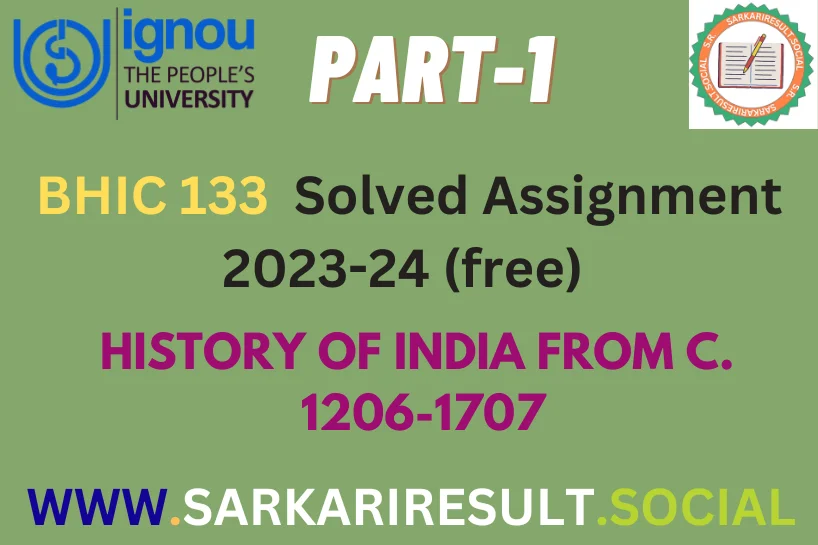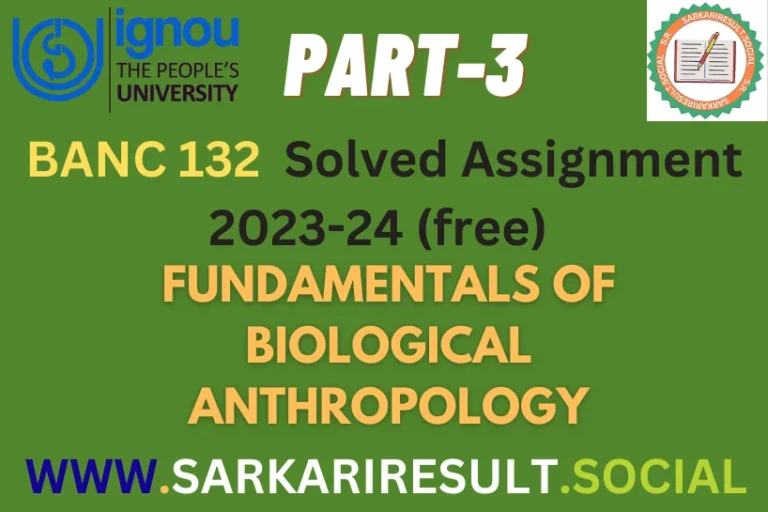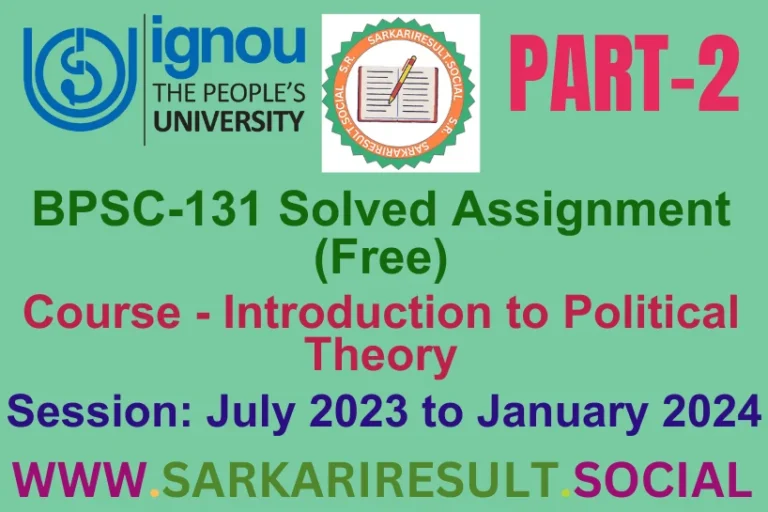BHIC 133 IGNOU Solved Assignment 2023-24 (free) Part -1

BHIC 133 IGNOU Solved Assignment 2023-24 (free) Part -1
Expand your historical horizons with BHIC 133 IGNOU Solved Assignment 2023-24 (free) Part -1, featuring two insightful questions, each inviting a detailed 500-word response. Our meticulous solutions maintain a formal tone, ensuring a comprehensive exploration within the prescribed word limits. Delve deeply into historical inquiries, meet the criteria with depth and precision, and excel in your academic pursuits. Access BHIC-133 IGNOU Assignment 1 solutions to elevate your historical comprehension and foster an enriched scholarly perspective.

1. Who were zamindars? Discuss their rights and perquisites.
Ans. Zamindars were revenue collectors or intermediaries who held considerable power and influence in the feudal system of Mughal and colonial India. They played a crucial role in revenue administration and land management, acting as local landlords or estate holders. Their rights and perquisites varied across different periods and regions.
Also Read This: BHIC 131 IGNOU Solved Assignment 2023-24 (free) Part -1
Rights and Perquisites:
1. Land Revenue Collection: Zamindars had the primary responsibility of collecting land revenue from peasants on behalf of the state. They assessed and collected taxes, often keeping a portion as their income while forwarding the rest to the ruling authority.
2. Land Ownership: Initially, zamindars held significant landownership rights. However, under the British system, they became more like revenue collectors, managing land under the authority of the colonial administration.
Also Read This: BHIC 131 IGNOU Solved Assignment 2023-24 (free) Part -2
3. Administrative Authority: Zamindars had administrative control over their estates. They settled disputes, maintained law and order, and were responsible for local governance within their territories.
4. Hereditary Succession: In many cases, zamindari rights were hereditary, passing from generation to generation within specific families. This practice perpetuated the zamindari system, creating a feudal-like structure.
Also Read This: BHIC 131 IGNOU Solved Assignment 2023-24 (free) Part -3
5. Perquisites and Privileges: Zamindars enjoyed certain privileges, including tax exemptions, judicial autonomy, and social status. They often held positions of influence, participating in local councils or assemblies.
6. Land Revenue Reductions: Some zamindars were granted the privilege of revenue reductions or exemptions as a reward for their services or loyalty to the ruling power.
Also Read This: BHIC 132 IGNOU Solved Assignment 2023-24 (free) Part -1
Changes Over Time:
1. Under Mughal Rule: During the Mughal era, zamindars held more autonomy and had substantial control over their estates. They were pivotal in the revenue system, playing a crucial role in the functioning of the empire.
2. British Colonial Period: The British introduced the Permanent Settlement in some regions, transforming zamindars into intermediaries for revenue collection. They lost significant land rights and autonomy, becoming more like rent collectors for the colonial administration.
Also Read This: BHIC 132 IGNOU Solved Assignment 2023-24 (free) Part -2
3. Land Revenue Assignments: Zamindars were granted the right to collect land revenue in return for fixed payments to the British. However, exploitative practices by some zamindars led to peasant exploitation and agrarian unrest.
4. Abolition of Zamindari System: Post-independence, various states in India implemented land reforms that sought to abolish the zamindari system, aiming for land redistribution, tenancy reforms, and fairer agrarian practices.
While zamindars wielded significant power and privileges, their role and influence varied across different historical periods and regions. Over time, changes in revenue systems, administrative policies, and socio-political transformations altered their rights and status, eventually leading to the abolition of the zamindari system in independent India’s pursuit of social and economic justice.
2. Discuss personnel of trade and commercial practices under the Mughals.
Ans. Under the Mughal Empire, trade and commerce flourished, supported by a robust system of personnel, policies, and practices that facilitated economic prosperity and cultural exchange.
Personnel of Trade:
1. Sahukars and Seths: These were prominent moneylenders and financiers who provided credit to merchants, facilitated transactions, and financed trade ventures. They played a crucial role in funding commercial activities.
2. Shroffs and Banyas: Shroffs were bankers who handled transactions and monetary matters. Banyas were merchants or traders who were involved in commercial exchanges, both within the empire and with foreign traders.
Also Read This: BHIC 132 IGNOU Solved Assignment 2023-24 (free) Part -3
3. Caravanserais and Trade Agents: Caravanserais provided accommodations and facilities for traveling merchants and traders. Trade agents acted as intermediaries, managing transactions, negotiating prices, and representing merchants.
4. Munshis and Accountants: Munshis were clerks or secretaries who managed commercial records, correspondence, and accounts. Accountants played a vital role in maintaining financial records and managing trade-related documentation.
Commercial Practices:
1. Court-Sponsored Trade: The Mughal court actively promoted trade by establishing trading posts, encouraging commerce through royal grants, and providing protection to merchants and traders. The court played a pivotal role in regulating and facilitating trade activities.
2. Land and Maritime Trade Routes: The Mughals developed an extensive network of land and maritime trade routes, connecting regions within the empire and fostering trade with distant lands like Persia, Central Asia, and Europe.
3. Monetary Systems and Coinage: The Mughals introduced standardized currency systems and coinage, enhancing trade efficiency and facilitating commercial transactions. They issued various coins of different denominations, ensuring stability in financial transactions.
Also Read This: Check BGDG 172 IGNOU solved assignment 2023-24 (Free)
4. Regulations and Taxation: The administration implemented policies regulating trade, setting tariffs, and taxation on goods and transactions. The imposition of customs duties and other taxes played a role in state revenue while also regulating commerce.
5. Guilds and Trade Organizations: Guilds, known as ‘Srenis’ or ‘Panchayats,’ were associations of artisans, traders, and merchants. These organizations regulated trade practices, set standards for craftsmanship, and protected the interests of members.
6. Commodities and Exports: Mughal India was known for its production and export of various commodities, including textiles (like muslin and silk), spices, indigo, opium, and precious stones, contributing to India’s prominence in the global trade network.
Impact and Legacy:
Also Read This: Check top Begae 182 IGNOU solved assignment 2023-24 (Free)
The efficient organization of trade personnel and commercial practices under the Mughals facilitated economic prosperity, cultural exchange, and the integration of diverse regions within the empire. Their emphasis on trade and commerce contributed to India’s status as a major commercial center and a vital player in the global economy.
The legacy of Mughal trade practices and systems continued to influence subsequent trade policies, financial systems, and commercial networks in India, leaving a lasting impact on the country’s economic history and cultural heritage.







